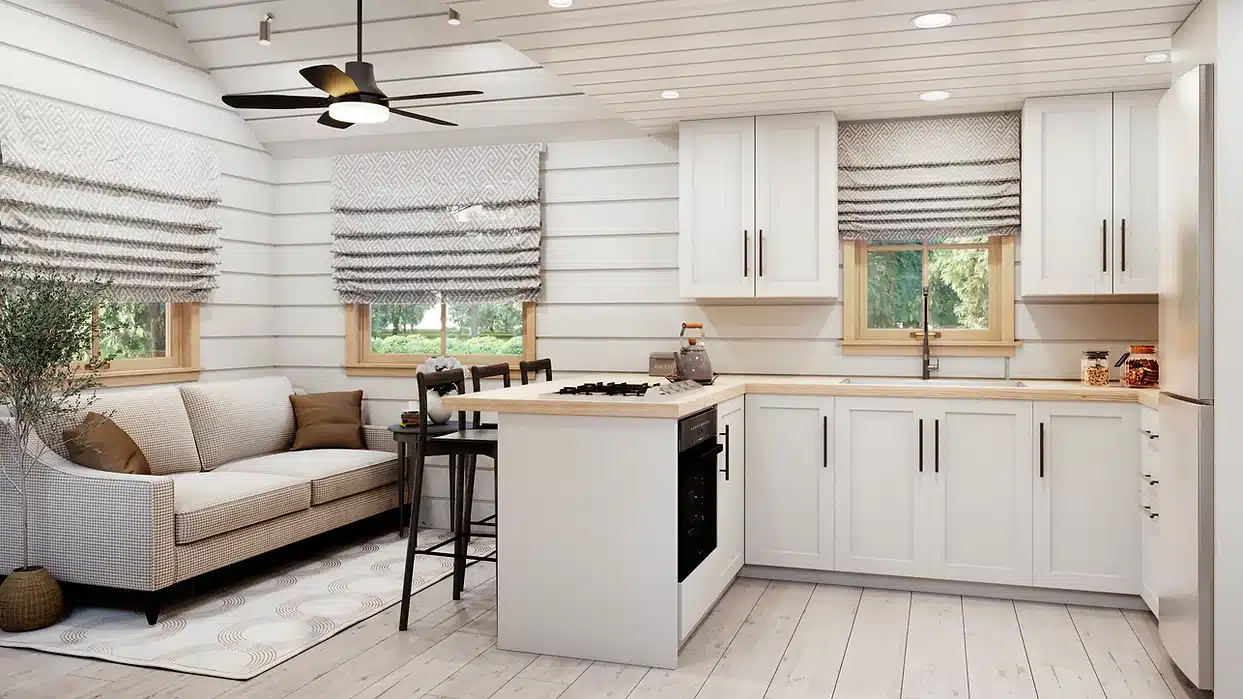Table of Contents
Introduction
Tiny homes are becoming increasingly popular due to their affordability, sustainability, and mobility. Designing and building a tiny home requires a great deal of planning and consideration for the many complex factors that come together to create the perfect tiny house. Fortunately, modern design software programs such as Autodesk Revit, McNeel Rhinoceros, and Enscape can help account for overlapping and complex factors when designing a tiny home. This article will discuss the complexities of designing and building a tiny house, the benefits of using design software programs to create tiny homes, features of these tools that can help with this process, and how to best utilize them.
Definition and overview of tiny homes
Tiny homes are typically defined as dwellings with an area of less than 400 square feet (37 m²). They are built on trailers or foundations and often include a kitchen, bathroom, bedroom, living space, and other amenities depending on the size of the dwelling. Tiny homes offer many advantages such as being more affordable than traditional housing options, providing more sustainable living options due to their smaller environmental footprint, and being more mobile than traditional houses.
Benefits of designing and building a tiny home
Designing and building a tiny home is an exciting challenge that allows you to get creative with your space while still adhering to regulations and safety standards. It also allows you to customize your home exactly how you want it without having to be limited by pre-made plans or kits. By utilizing modern design software programs for designing your tiny home you can easily account for overlapping factors such as door size, structure foundation requirements, free space in certain rooms, materials selection based on durability/efficiency/appearance considerations, etc., all while reducing chances of human error.
Regulations to Consider When Designing Tiny Homes
When designing and building a tiny home, there are a few regulations to consider in order to ensure the safety of its inhabitants. The most important regulations include door size, structure foundation, and free space in certain rooms.
Door Size
The doorway of a tiny home should be at least 36 inches wide and 80 inches tall, so that it can accommodate people of all sizes. This is especially important for those with mobility issues or who use wheelchairs. Additionally, the doors should be easy to open and close from both sides with minimal effort.
Structure Foundation
The structure of a tiny home must be strong enough to withstand extreme weather conditions such as wind, rain, snow, and earthquakes. It is also important to make sure that the foundation is level and stable before beginning construction on the house itself.
Free Space in Certain Rooms
In order to ensure that a tiny home is livable, it must have at least 70 square feet of free space in each room. This includes bedrooms, bathrooms, kitchens, living rooms, etc., so that inhabitants are not cramped or uncomfortable while inside their homes.
Main Idea: Regulations to consider when designing a tiny home include door size, structure foundation, and free space in certain rooms. Key findings: Doorways must be 36 inches wide and 80 inches tall; structure must be strong enough to withstand extreme weather; each room must have at least 70 square feet of free space.
Materials and Efficiency
When designing a tiny home, it is important to consider the materials used as well as the efficiency of the design. Durability, efficiency, and appearance are all important components that need to be taken into account when building a tiny home.
Durability, Efficiency, and Appearance
Durability is an important factor to consider when constructing a tiny home. The materials used should be able to withstand the elements and should not require frequent repairs or replacements. Additionally, the materials should be energy efficient to help keep utility costs down. Lastly, it is important that the materials chosen are aesthetically pleasing so that the tiny house will look attractive both inside and out.
Average Cost to Build a Tiny Home without a Building Kit
The average cost of building a tiny home without a building kit can vary greatly depending on the materials used and the complexity of the design. Generally speaking, it can cost anywhere from $20,000-$50,000 USD to build a tiny home without any prefabricated components or kits. This price range includes labor costs such as plumbing, electrical work, carpentry, etc., as well as material costs for things like lumber, insulation, drywall, siding, roofing shingles, windows and doors.
Overlooking Small Details Can Lead To Consequences
It is also important to note that overlooking small details in your design can lead to costly consequences down the road if not addressed properly during construction. For example, if you overlook proper ventilation in your design then you may end up dealing with mold or mildew issues in your tiny house later on down the line which could result in costly repairs or replacement of certain items such as walls or furniture pieces. Additionally, overlooking small details such as making sure your windows open properly or ensuring proper drainage systems are in place can lead to water damage which could cause even more expensive repairs in the future if not addressed immediately during construction.
|
Material
|
Durability
|
Efficiency
|
Aesthetics
|
Cost
|
|
Lumber
|
High
|
Low
|
Low
|
High
|
|
Insulation
|
High
|
High
|
Low
|
Medium
|
|
Drywall
|
Medium
|
Low
|
High
|
Low
|
|
Siding
|
High
|
Medium
|
Medium
|
Medium
|
|
Roofing Shingles
|
High
|
Medium
|
Low
|
Medium
|
|
Windows and Doors
|
High
|
Medium
|
High
|
Medium
|
Best Design Software for Designing a Tiny Home
Designing and building a tiny home can be an exciting and rewarding experience. However, it is also complex and requires careful consideration of overlapping factors such as regulations, materials, and efficiency. Fortunately, modern design software programs can help to account for all of these factors while allowing you to create beautiful tiny homes that are tailored to your needs.
Autodesk Revit and McNeel Rhinoceros
Autodesk Revit is a powerful 3D modeling software program used by architects, engineers, interior designers, builders, contractors, and other professionals in the construction industry. It offers a wide range of features to help with the design process including real-time walkthroughs, virtual reality (VR), workflow management tools, materials library, assets library, and more.
McNeel Rhinoceros is another popular 3D modeling software program used by architects, engineers, interior designers, builders, contractors, and other professionals in the construction industry. It offers features similar to Autodesk Revit but with an emphasis on creating detailed models for tiny homes or other small structures. The software is easy to use and allows you to quickly create detailed models of your tiny home from start to finish.
Enscape 3D Design Software Programs
Enscape 3d design software programs are specifically designed for creating stunning visuals for tiny homes or other small structures. The software has an intuitive user interface that makes it easy to create detailed models quickly and efficiently. Additionally, Enscape offers features such as real-time walkthroughs and VR capabilities which allow you to explore your design in detail before committing any resources or time towards building it.
Real-time Walkthroughs, Virtual Reality Workflow Materials Assets
Real-time walkthroughs are one of the most useful features offered by modern design software programs when designing a tiny home or any other small structure. This feature allows you to virtually explore your design in detail before committing any resources or time towards building it. Additionally, virtual reality (VR) capabilities allow you to experience your design in a realistic environment before actually constructing it in real life; this helps you identify potential problems early on so they can be addressed before construction begins.
Workflow management tools help streamline the entire process from concept to completion while materials libraries provide access to a wide variety of textures and colors that can be used in your designs; this helps ensure that your tiny home looks exactly how you envisioned it before beginning construction work on it. Lastly, asset libraries offer access to furniture pieces and other objects that can be used in your designs; this helps make sure that all elements fit together perfectly within the space available for your tiny home’s construction project.
Overall, modern design software programs offer many benefits when designing a tiny home or any other small structure; they make the process easier by accounting for overlapping factors such as regulations, materials selection/efficiency considerations and more while providing realistic visuals that help bring your vision alive before starting construction work on it. The best design software programs for designing a tiny home include Autodesk Revit & McNeel Rhinoceros as well as Enscape 3D which offer features like real-time walkthroughs & VR capabilities along with workflow management tools & materials/assets libraries that make designing & constructing a tiny home easier than ever before!
Utilizing the Best Design Software
Using a design software program to create a tiny home can save time and money while ensuring that all regulations are met and that the home is efficient and visually appealing. Autodesk Revit, McNeel Rhinoceros, and Enscape 3D are three of the most popular design software programs used for designing tiny homes. These programs allow users to easily account for overlapping and complex factors when building a tiny home, such as door size, structure foundation, free space in certain rooms, durability, efficiency, and appearance.
Revolutionary Technology like VR
Autodesk Revit offers revolutionary technology like virtual reality (VR) which allows users to take a real-time walkthrough of their tiny home designs before construction begins. This helps reduce chances of human error by allowing users to make changes in real-time rather than having to go back and make costly corrections after construction has already started. Additionally, this feature ensures that the end product matches the user’s vision from the start. McNeel Rhinoceros also offers VR technology so users can experience their designs in 3D before beginning construction.
Reducing Chances of Human Error
Enscape 3D also provides features like workflow optimization, real-time material editing, asset library integration, and more that help reduce chances of human error when designing a tiny home. Allowing users to work with their designs in real-time reduces mistakes made during the design process which saves time and money on corrections later on. Additionally, these features provide an easier way for users to visualize their projects before beginning construction.
By utilizing these design software programs when creating a tiny home, users can ensure that all regulations are met while taking into account factors such as door size, structure foundation, free space in certain rooms, durability, efficiency, appearance as well as many other aspects of building a tiny home. The use of modern software programs also reduces chances of human error during the design process which saves time and money later on down the line.
Main idea: Design software programs like Autodesk Revit, McNeel Rhinoceros, and Enscape 3D enable users to create efficient and visually appealing tiny homes while reducing chances of human error.
Conclusion
Designing and building a tiny home can be a complex process, but modern design software programs such as Autodesk Revit, McNeel Rhinoceros, and Enscape make it easier to account for overlapping and complex factors. These tools provide features like real-time walkthroughs, virtual reality, workflow, materials, assets, and more that can help reduce the chances of human error. This article encourages readers to use these powerful tools to create their own tiny homes and reap the many benefits they offer.


